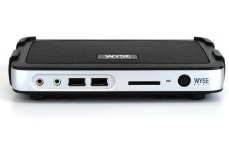Wyse Intros Linux-Based Thin Client for Cloud Computing on a Budget

The Wyse T50 includes a 1 GHz ARMv7 processor and features a start-up time of less than 20 seconds. |
Wyse has introduced its new entry-level thin client, the Wyse T50. Geared toward organizations on a budget, the T50 includes Wyse-enhanced Linux firmware, a simplified user interface, "plug and display" startup of less than 20 seconds, and the ability to display multimedia and Flash in virtual desktop infrastructure (VDI) and the local browser.
The Wyse T50 is equipped with the Marvell ARMADA PXA 510 processor, which is an ARMv7 CPU running at 1 GHz, and is compliant with Energy Star version 5.0 and the Electronic Product Environment Assessment Tool (EPEAT). The T50 is remote desktop protocol (RDP) 7 compliant and works within Citrix, Microsoft, and VMware environments.
Key features of the Wyse T50 include:
- Software-only acceleration of virtual desktops and applications;
- Accelerations of existing Citrix ICA and Microsoft RDP products;
- Accelerated connections to Citrix XenApp, Citrix XenDesktop, VMware View, Microsoft Terminal Server, and Microsoft Hyper-V VDI;
- Support for WANs and "fat, long pipes";
- Improved Wyse TCX software suit functionality across WANs;
- Support for Wyse Collaborative Processing Architecture across WANs;
- Administrator console for control of maximum bandwidth per connection; and
- Built-in security of underlying protocols (128-bit encryption for RDP and ICA).
The Wyse T50 is available now. Further information can be found here.
About the Author
Leila Meyer is a technology writer based in British Columbia. She can be reached at [email protected].